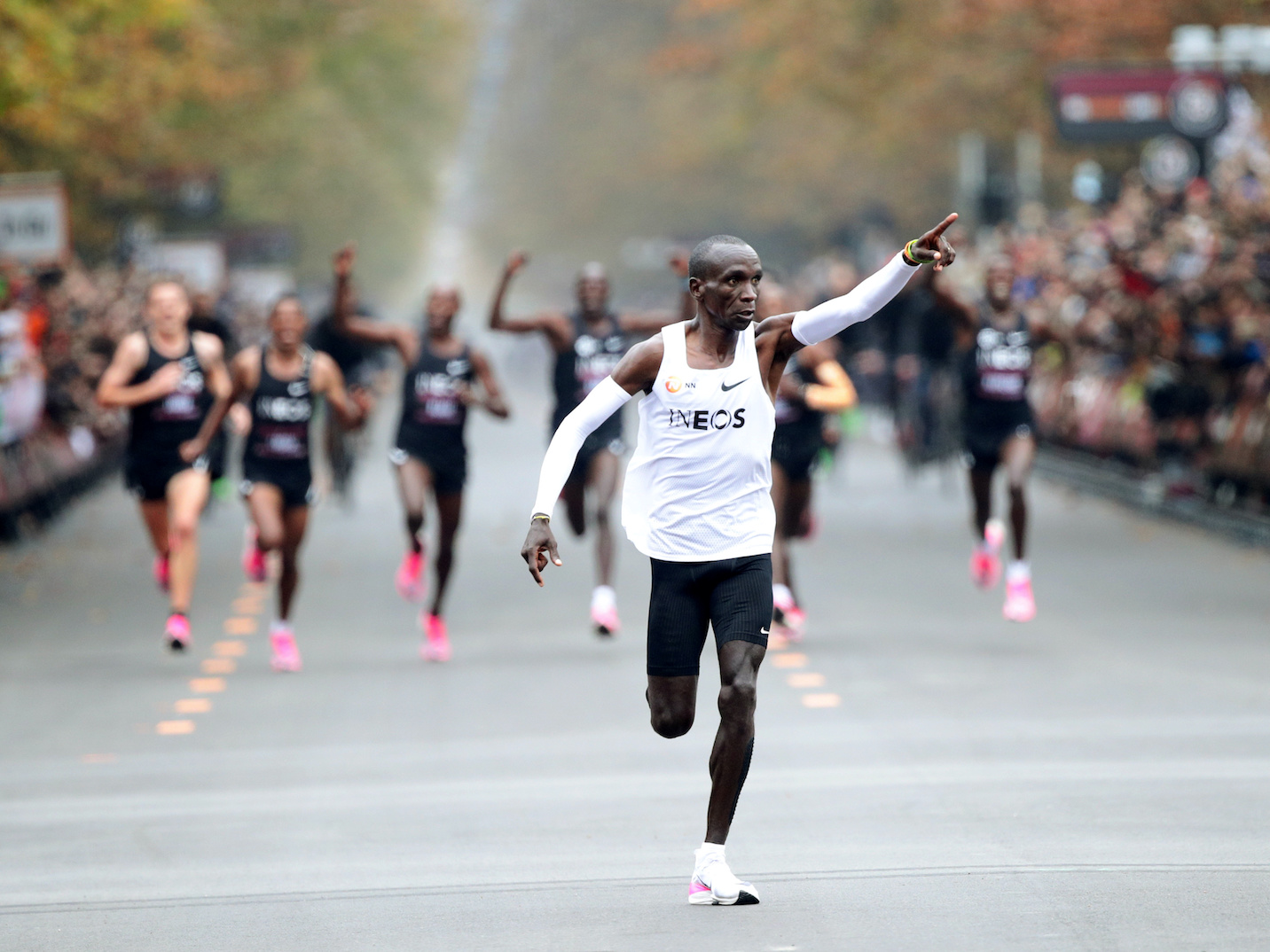- On Saturday, the Kenyan runner Eliud Kipchoge completed a marathon in under two hours – his time was one hour, 59 minutes, and 40 seconds.
- While that makes Kipchoge the first person to run 26.2 miles in under two hours, the feat won’t count as a world record.
- That’s because Kipchoge was supported by a rotating team of pacesetters, followed a car that used lasers to indicate the best place to run on the road, and had other advantages not available during a typical marathon.
- Visit Business Insider’s homepage for more stories.
For the past eight years, the Kenyan runner Eliud Kipchoge has been trying to become the first person to finish a marathon in under two hours.
Kipchoge, who is 34 years old and won an Olympic gold medal running the marathon in 2016, came painfully close in 2017: He finished a race in Italy just 25 seconds over the two-hour mark. Last year, he finished the Berlin Marathon just one minute and 39 seconds over.
But on Saturday, Kipchoge finally did it: He completed the Ineos 1:59 Challenge marathon in Vienna – an event arranged specifically for his sub-two-hour attempt – in one hour, 59 minutes, and 40 seconds.
Kipchoge’s average mile pace was under four minutes and 34 seconds.
"I am the happiest man in the world to be the first human to run under two hours, and I can tell people that no human is limited," Kipchoge said. "I expect more people all over the world to run under two hours after today."

The International Association of Athletics Federations (IAAF), however, will not be honoring the feat as a world record.
That's because Kipchoge had advantages that set this event apart from a traditional marathon, including a phalanx of pacesetters who reduced Kipchoge's wind resistance, a pace car that used lasers to indicate the best running paths for those pacesetters to take, and a race course that was, essentially, flat.
Why Kipchoge did not set a world record
Kipchoge's pace through the Saturday marathon was remarkably consistent, and not by accident. He was accompanied at all times by a group of pacesetters - many Olympians themselves. These fellow runners flanked Kipchoge in front and behind, helping him keep a steady pace and forming a human shield against wind.
The formation of these pacesetters, five in a V-shape ahead of Kipchoge and two at his heels, was meant to minimize wind resistance, the IAAF's Bob Ramsak reported.
"The pacemakers did a great job - they are among the best runners of all time," Kipchoge said. "I thank them and appreciate them for accepting to do the job."
But the members of this mobile shield rotated during the course to ensure they could keep pushing Kipchoge to the edge of his endurance limits - and IAAF rules forbid pacesetters from hopping in midway through a race.

Additionally, Kipchoge and his pacesetters were helped by an electric car that drove just ahead of them. The vehicle showed Kipchoge his current time and also came equipped with laser beams that projected the ideal running positions for his pacesetters on the road.
The Economist reported that, according to an estimate by the sports scientist Ross Tucker, Kipchoge gained two minutes thanks to his pacesetters and the car. Given that Kipchoge finished the race just 20 seconds under two hours, those were crucial minutes.
Also, the IAAF doesn't consider the Ineos 1:59 Challenge event a real race, as it was tailor-made for Kipchoge's sub-two-hour marathon attempt. No competitors joined Kipchoge on the course, the IAAF's president, Sebastian Coe, told Reuters.
"It wasn't sanctioned as a world record because it wasn't in open competition," he said.
Event organizers created ideal conditions for Kipchoge's marathon attempt
The course in Vienna was chosen specifically to help Kipchoge attempt a sub-two-hour marathon. There were just 2.4 meters of incline over the route, so he never had to sprint uphill. The event also took place on a 6-mile loop with minimal curves (curves require runners to exert more energy than sprinting in a straight line).
What's more, Vienna sits at sea level, so Kipchoge got the maximum amount of oxygen possible.
The event organizers even tried to maximize how conducive the weather would be to Kipchoge's success: Meteorology and performance experts determined that the optimal start date for the run would be Saturday. That's when the city's temperature, humidity, wind, and precipitation forecasts were optimal, Robby Ketchell, who led Ineos' weather analysis, told Reuters.
"For the Challenge, we need a 24-hour window of no rain to keep all the surfaces dry," Ketchell added.

Plus, Ineos-sponsored runners and cyclists passed Kipchoge unlimited drinks and energy gels every 5 kilometers or so.
And finally, according to the Economist, Kipchoge also wore a never-before-seen version of Nike's Vaporfly shoes. The sneakers, which aren't on the market yet, feature carbon-fiber plates in the sole to help runners get the most forward push for each stride. A February 2019 study done by researchers unaffiliated with Nike found that the shoes improved runners' energy efficiency by 4% compared with other sneakers.
A 'man on the moon' moment
Kipchoge's Berlin marathon time of two hours, one minute, and 39 seconds is already the world record.
But for him, this sub-two-hour marathon wasn't about breaking another record - the IAAF made it clear well ahead of time that the event results wouldn't be sanctioned. Instead, Kipchoge saw the athletic achievement as akin to Neil Armstrong's first step onto the lunar surface in 1969.
Kipchoge said on Thursday (before the race) that the feat would be "making history in this world, like the first man to go to the moon."

After he finished the race, Kipchoge hugged his wife and his daughter at the finish line.
"That was the best moment of my life," he said.

